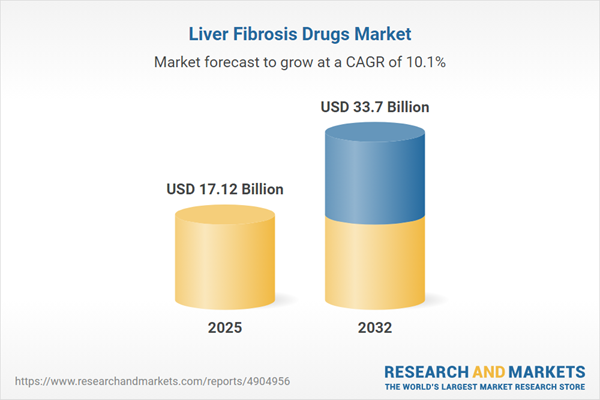Speak directly to the analyst to clarify any post sales queries you may have.
The liver fibrosis drugs market is rapidly evolving, shaped by innovative therapies, changing regulations, and increasing competition. Senior healthcare executives face a complex landscape that requires forward-looking strategies and adaptive operations.
Market Snapshot: Liver Fibrosis Drugs Market Growth and Dynamics
The global liver fibrosis drugs market is experiencing notable expansion, driven by rising rates of chronic liver diseases and increasing demand for next-generation treatments. Expansion of product pipelines by major pharmaceutical companies is diversifying available biologics, cell and gene therapies, and digital patient engagement platforms. This heightened industry activity underscores the significance of integrating advanced R&D with scalable technologies across all market regions. The continuous consolidation and evolving compliance environment compel organizations to invest in risk management, strategic alliances, and technology-driven solutions capable of adapting to shifting industry requirements.
Liver Fibrosis Drugs Market: Scope & Segmentation
Comprehensive understanding of this market empowers senior executives to optimize their organization’s positioning and capture growth opportunities. The main competitive segments and strategic differentiators include:
- Drug Class: Biologics, monoclonal antibodies, recombinant proteins, and advanced cell and gene therapies are widening treatment protocols, improving patient targeting and outcome predictability. Small molecule inhibitors remain pivotal in multipronged regimens for liver fibrosis care.
- Mechanism of Action: Emerging products employ targeted approaches such as ASK1 inhibitors, galectin-3 inhibitors, PPAR agonists, and TGF beta antagonists. This focus on mechanism specificity supports measurable clinical progression and advances the move toward precision medicine.
- Route of Administration: Intravenous, subcutaneous, and oral drug formats grant flexibility in patient management, supporting both hospital-based initiatives and community-level implementation for greater access and compliance.
- Distribution Channel: Availability through hospital networks, retail pharmacies, and digital health platforms extends treatment reach, especially where infrastructure is fragmented or underdeveloped, enhancing overall therapy distribution.
- Region: Tailored market entry strategies for the Americas, Europe, Middle East, Africa, and Asia-Pacific are essential. Regional differences in compliance expectations and healthcare ecosystems require organizations to adapt commercialization and regulatory models to local market dynamics.
- Key Companies: Industry leaders such as Gilead Sciences, AbbVie, F. Hoffmann-La Roche, Bristol-Myers Squibb, Pfizer, Novartis, Takeda Pharmaceutical, Merck & Co., Intercept Pharmaceuticals, and Madrigal Pharmaceuticals set standards for clinical development and commercial execution, underpinned by strong R&D resources and supply chain robustness.
Liver Fibrosis Drugs Market: Key Takeaways for Senior Decision-Makers
- Advances in biologics, as well as cell and gene therapies, are accelerating the transition to individualized care and enabling scalable treatment delivery across diverse patient groups.
- Integration of digital health technologies supports ongoing patient monitoring and drives actionable analytics for executive-level decision-making.
- Deployment of mechanism-specific drugs facilitates value-based care initiatives, aligning pharmaceutical objectives with industry trends in reimbursement and patient outcomes.
- Expanding treatment modalities, with emphasis on oral therapies, enhance patient engagement and broaden market penetration in both established and evolving healthcare systems.
- Collaborative partnerships between pharmaceutical and biotech firms strengthen supply chain resilience, enhance risk management, and facilitate more agile organizational responses during periods of rapid market change.
Tariff Impact: Navigating Supply Chain Disruptions
Recent updates to U.S. pharmaceutical tariffs have made it vital for executives to review global supply chain models and consider partnerships with domestic contract manufacturers. These measures help ensure continuity in therapy availability, maintain competitive pricing, and reinforce organizational resilience in the face of market instability.
Methodology & Data Sources
This analysis draws on primary interviews with industry leaders, targeted input from sector experts, and a structured review of clinical trials, regulatory data, and current market literature. Ongoing engagement with stakeholders ensures findings address the priorities and realities faced by executive teams.
Why This Report Matters
- Provides actionable frameworks for executive risk management and strategic growth within the liver fibrosis drugs market.
- Enables compliance with evolving regulatory requirements and enhances agility in adapting to sector changes and supply chain risks.
- Gives organizations the insights needed to align strategy with rapid market shifts and sustain competitive advantage in this dynamic industry segment.
Conclusion
This report equips senior leaders with the knowledge to reinforce strategic direction, integrate breakthrough therapies, and maintain resilience and competitiveness in the transformative liver fibrosis drugs market.
Additional Product Information:
- Purchase of this report includes 1 year online access with quarterly updates.
- This report can be updated on request. Please contact our Customer Experience team using the Ask a Question widget on our website.
Table of Contents
3. Executive Summary
4. Market Overview
7. Cumulative Impact of Artificial Intelligence 2025
Companies Mentioned
The companies profiled in this Liver Fibrosis Drugs market report include:- Gilead Sciences, Inc.
- AbbVie Inc.
- F. Hoffmann-La Roche Ltd.
- Bristol-Myers Squibb Company
- Pfizer Inc.
- Novartis AG
- Takeda Pharmaceutical Company Limited
- Merck & Co., Inc.
- Intercept Pharmaceuticals, Inc.
- Madrigal Pharmaceuticals, Inc.
Table Information
| Report Attribute | Details |
|---|---|
| No. of Pages | 186 |
| Published | October 2025 |
| Forecast Period | 2025 - 2032 |
| Estimated Market Value ( USD | $ 17.12 Billion |
| Forecasted Market Value ( USD | $ 33.7 Billion |
| Compound Annual Growth Rate | 10.1% |
| Regions Covered | Global |
| No. of Companies Mentioned | 11 |









